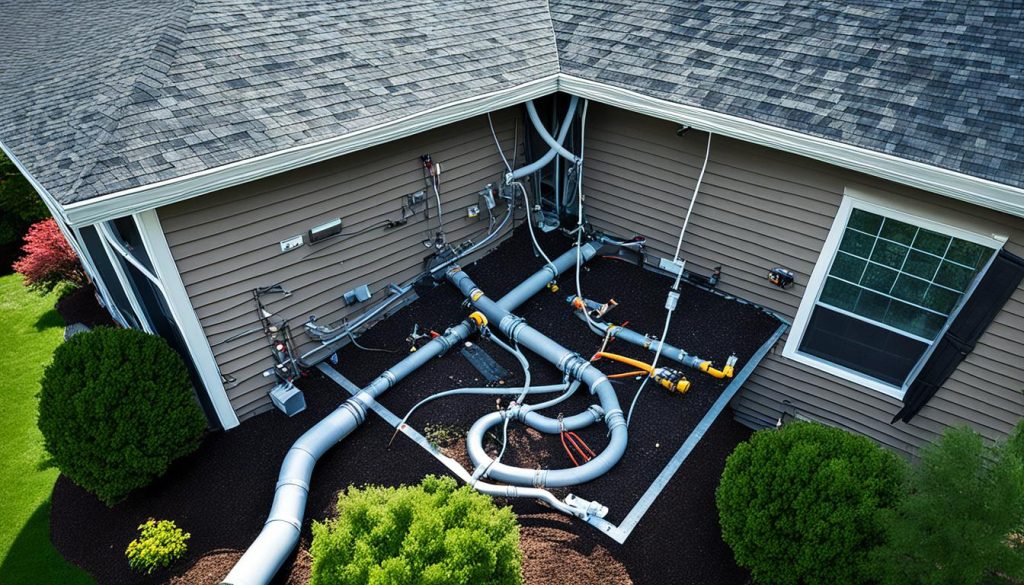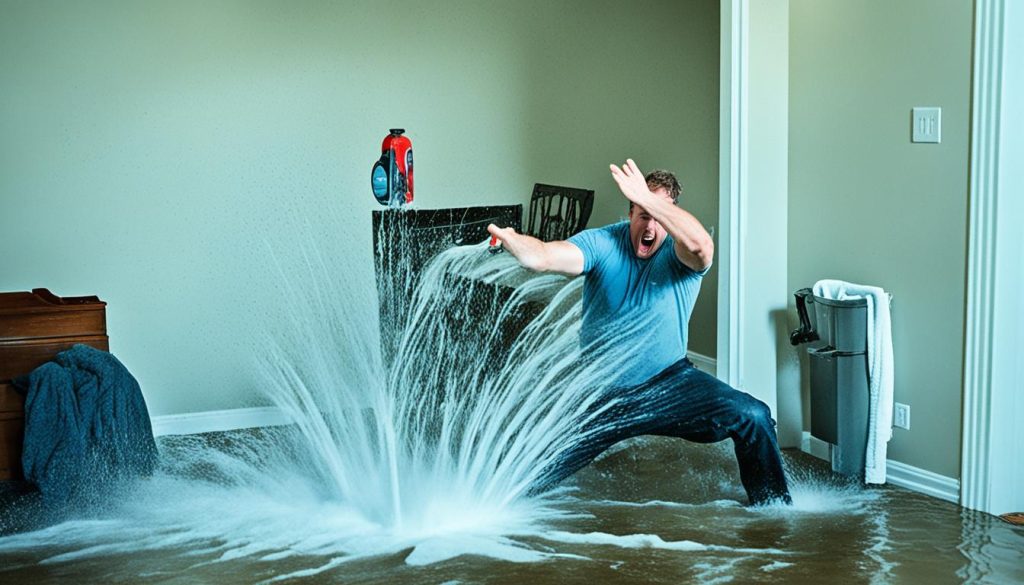Plumbing VTR Expertise for Your Home Needs
Did you know that according to the International Plumbing Code (IPC), vent pipes must extend at least 6 inches above a roof? In snow-prone areas, they should even extend 24 inches above the roof. That’s where the TUBOS® system comes in. It is a user-friendly plumbing vent pipe extension that ensures compliance with building codes by extending roof pipes.
Key Takeaways:
- The TUBOS® system is a cost-effective and easy-to-install plumbing vent pipe extension.
- It ensures compliance with building codes by extending roof pipes.
- Vent pipes must extend at least 6 inches above a roof, and even more in snow-prone areas.
- TUBOS® saves an average of $35 per installation.
- By using TUBOS®, you can avoid potential issues and ensure proper ventilation in your plumbing system.
Understanding Drain and Vent Configurations
When it comes to plumbing systems, it’s crucial to have a clear understanding of drain and vent configurations. Properly designed drainage systems rely on the correct installation of vent stacks and stack vents to ensure optimal functionality. In this section, we’ll explore the differences between these two components and their importance in meeting plumbing code requirements.
Differences Between Vent Stacks and Stack Vents
Vent stacks and stack vents serve different purposes in a plumbing system. Vent stacks are responsible for carrying waste and connecting to the drainage stack, while stack vents act as extensions of the waste stack, providing venting capabilities. Understanding these distinctions is vital to ensure the efficient operation of your plumbing system while adhering to plumbing code regulations.
According to plumbing codes, a vent stack is required for every five branch intervals in a drainage system. This requirement ensures adequate ventilation and prevents the buildup of sewer gas. Additionally, every building with plumbing must have at least one main vent stack.
Stack vents, on the other hand, directly extend to the outside air and play a crucial role in preventing sewer gas from accumulating within the plumbing system. They also contribute to efficient drainage and proper toilet operation. Understanding the role and placement requirements of both vent stacks and stack vents is essential to maintain a well-functioning plumbing system.
Proper Installation for Compliance with Plumbing Code
Plumbing codes outline specific requirements for the installation of vent stacks and stack vents to ensure compliance with industry standards and building codes. These requirements include the minimum height that vent stacks should extend above the roof and the minimum distance between stack vents and potential sources of contamination.
To better understand these placement requirements, refer to the table below:
| Vent Stack | Stack Vent |
|---|---|
| Minimum height of 6 inches above the roof | No specific height requirement |
| Every five branch intervals | Placed strategically for efficient venting |
| Required in every plumbing building | Essential for proper drainage and toilet operation |
By adhering to these regulations, you can ensure the safety and functionality of your plumbing system while avoiding potential issues such as sewer gas buildup or drainage problems.
Proper Placement of VTRs for Drainage
When it comes to plumbing vent pipes, proper placement is crucial to ensure efficient drainage and prevent roof leaks. Building code requirements specify that these pipes should extend at least 6 inches above the roof surface. Additionally, VTRs (Vent Terminal Roof) should be maintained with a minimum height of 8 inches. Failure to meet these requirements can result in water damage, mold growth, and costly repairs.
To avoid these issues, it’s essential to work with professional plumbers who have expertise in plumbing vent pipe installation. They will ensure that all vent pipes are correctly positioned according to building code regulations. By partnering with knowledgeable professionals, you can have peace of mind knowing that your plumbing system is compliant and protected.
Benefits of Hiring Professional Plumbers
When it comes to your plumbing needs, it’s crucial to rely on the expertise and experience of professional plumbers. Whether you’re dealing with a simple repair or an emergency plumbing situation, choosing the right professionals can make all the difference. Here are some key benefits of hiring professional plumbers:
- Expertise and Experience: Professional plumbers have undergone extensive training and have the necessary knowledge to handle various plumbing tasks. They are equipped with the skills to diagnose and resolve plumbing issues effectively.
- Emergency Plumbing Services: Plumbing emergencies can happen at any time. With professional plumbers, you can have peace of mind knowing that they are available 24/7 to address your emergency plumbing needs promptly. Their quick response time can help minimize damage and inconvenience.
- Access to Quality Tools and Equipment: Professional plumbers use state-of-the-art tools and equipment to ensure accurate repairs and installations. This allows them to deliver high-quality workmanship and long-lasting solutions.
- Expert Problem-Solving: Plumbing problems can be complex, and sometimes a DIY approach can only worsen the situation. Professional plumbers have the expertise to identify the root cause of the problem and provide effective solutions. Their problem-solving skills can save you time, money, and frustration.
- Guaranteed Workmanship: Reputable plumbing companies and local plumbing contractors often provide guarantees for their work. This means that if any issues arise after the service, they will address them without additional charges. Hiring professional plumbers ensures that the job is done right the first time.
By choosing a professional plumbing company or a local plumbing contractor, you can have confidence that your plumbing repairs and installations are in the hands of skilled professionals. They can also provide regular maintenance services to prevent future problems and extend the lifespan of your plumbing system.
In the next section, we will explore the range of residential and commercial plumbing services offered by professional plumbers.
Residential and Commercial Plumbing Services
When it comes to plumbing services for your home or business, professional plumbers offer a wide range of solutions to meet your needs. Whether you’re dealing with a plumbing repair, installation, or upgrade, these experts have the knowledge and skills to get the job done right.
In residential settings, licensed plumbers can tackle various issues, from fixing a leaky faucet to installing a new plumbing system. They understand the unique challenges that homeowners face and provide efficient, reliable solutions to ensure your plumbing operates smoothly.
For commercial properties, professional plumbers are equipped to handle complex plumbing systems found in businesses, offices, and other commercial settings. They can address plumbing repairs and perform installations to meet the specific requirements of each property. By hiring licensed plumbers, you can ensure that your commercial plumbing needs are met with high-quality workmanship and adherence to industry standards.
Whether you need plumbing repairs in your home or commercial space, it’s important to rely on professionals who have the expertise and experience to provide prompt, efficient solutions. By hiring licensed plumbers for your plumbing needs, you can have peace of mind knowing that your property’s plumbing system is in capable hands.
Source Links
- https://www.diychatroom.com/threads/proper-vtr-location.544922/
- https://www.rooferscoffeeshop.com/post/do-your-vent-pipe-extensions-meet-building-code-requirements
- https://pamperingplumber.com/difference-vent-stacks-stack-vents/
- Investing Wisely: How Windows & Doors in Boost Property Value and Financial Health - April 24, 2025
- The Financial Impact of Personal Injuries: Why Legal Help Matters for Business Owners - April 16, 2025
- The Hidden Financial Costs of Domestic Assault: What Business Owners Need to Know - April 16, 2025













